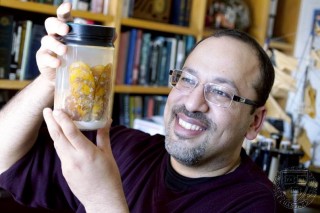My name is Peter Girguis, and on behalf of the science party and the Schmidt Ocean Institute I welcome you to our expedition’s blog. We hope that you will join us throughout the entire expedition as we explore some of the most amazing animal and microbial communities that live in the deep sea, and aim to better understand how humankind’s activities might impact their future.
For centuries, many people believed that the deep sea was full of monsters, and some believed that the ocean had no bottom. While these notions were put to rest by the first submersible dives in the 1930s, the deep sea continued to be viewed as a barren expanse of emptiness, populated by a few strange creatures that eeked out a modest living by eating the debris that rains from above.
In 1977, however, scientists made one of the most astonishing discoveries of the 20th century: deep sea hydrothermal vents. In the deep waters off the Galapagos Islands, scientists found seafloor hot springs with water as hot as an oven, as acidic as vinegar, and enriched in metals like iron, copper, zinc, lead, silver and gold. Amazing life forms were found to flourish in the cooler waters around these vents. From clams the size of dinner plates to giant mouthless tubeworms, the novel animals and microbes that live at these vents shattered our notions about where life could thrive.

We now know that these underwater hot springs are formed as seawater percolates through cracks in the seafloor, gets heated to hundreds of degrees by heat from deep within the Earth, then gushes out into the ice-cold ocean water as a hot, acidic jet or spring of water. Microbes that can make a living by “breathing” the chemicals in the vent water abound at these sites, and in turn support a vibrant community of animals that make their living by eating these microbes. Many of the animals form symbiotic partnerships with microbes. Symbioses is a term scientists use to describe two or more species that coexist and, typically, provide benefits to one another (more on that in a later blog post). Briefly, the animals provide their bacterial symbionts with chemicals from the vent water, which the bacteria use to generate energy and produce sugars to feed themselves and their animal host.
Today we are embarking on a research expedition to visit hydrothermal vents in the South Pacific. These particular deep sea vents are found about 1.5 miles (~2400 m) below sea level, nestled between the islands of Fiji, Tonga and Samoa. Like the first vents discovered off the Galapagos Islands, these vents are teeming with life, from microbial mats to snails, mussels, barnacles and fish. The snails and mussels dominate these vent sites, and are symbiotic with bacteria. During this expedition, our research will focus on better understanding these symbiotic relationships and how they are affected by natural and human-induced (i.e. anthropogenic) changes in their environment. In particular, we want to know more about how these communities change over time. To that end we will be visiting some long-term study sites that scientists from Penn State University established nearly 15 years ago to see if the communities are still thriving and what –if any- biological or chemical changes have occurred over time. We also want to learn more about the symbioses, and whether each animal species always partners with specific bacterial type, or if these symbiotic partnerships change as the environment changes. Also, for the first time, we will be looking into how these animals and microbes might respond to deep sea mining. The increasing demand for precious metals has led companies to start mining deep sea hydrothermal vents for copper, gold, silver and other metals. On this cruise we will see how vent animals respond to exposure to the kinds of particles that might arise during seafloor mining operations. These data can be helpful to managing and mitigating the impacts of mining on these unique deep sea communities.
These studies will, of course, further our knowledge about these particular animals and microbes, but they are equally important for broadening our understanding of how living creatures interact with the world around them. For example, we will learn more about how animals interact with bacteria that are beneficial to their well being, and about how microbes change the chemical composition of their environment, making those locales more habitable to animals. Finally, we hope that these data will help policymakers best manage the natural resources of the deep sea.
Though we are long past the days of seeing the ocean as a bottomless pit, our understanding of life in the deep sea is still in its infancy. Stay tuned to learn more about the science, and the scientists, who are leading these efforts.

